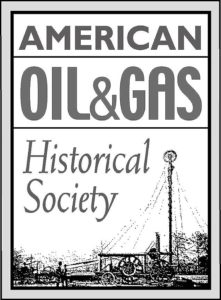by Bruce Wells | Mar 1, 2025 | Energy Education Resources
Oklahoma museum opened in 2011 to preserve history of Sooners and the American West.
The Cherokee Strip Regional Heritage Center (CSRHC) in Enid, Oklahoma, preserves the history of the settling the Cherokee Strip — and the search for petroleum in northwestern Oklahoma. The museum opened in 2011 following six years of work by many Enid residents, including a leading independent producer.
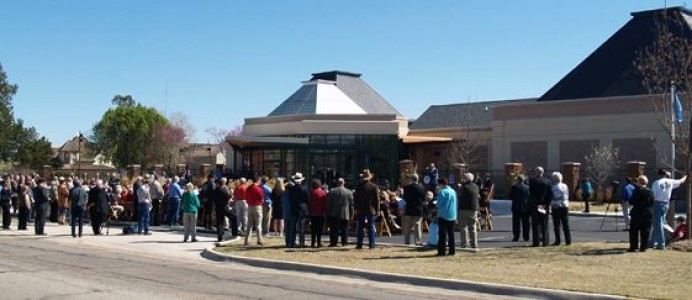
Hundreds gathered for the April 1, 2011, opening of the $10 million Cherokee Strip Regional Heritage Center on the east side of Enid, Oklahoma.
Overlooking a Chisholm Trail watering hole, CSRHC stands on “one of the most meaningful spots in the history of the American West” and includes the Humphrey Heritage Village, site of the only remaining U.S. Land Office from the 1893 Cherokee Strip Land Run.
Staking a claim to a piece of land on the day of the land run was a hard journey for those who poured over the border on September 16, 1893. Known as the Cherokee Outlet Opening or the Cherokee Strip Land Run, it followed the more famous first land run into unassigned lands of former Indian Territory on April 22, 1889.

CSRHC Chairman Llewellyn “Lew” O. Ward III (1930-2016) addressed a crowd gathered at the latest cultural addition to Enid on April 1, 2011. “Opening the heritage center is the closing of one chapter, but just the beginning of another to fulfill our pledge of claiming our past and inspiring our future,” announced Ward, who was instrumental in establishing the facility.
The $10 million center’s opening followed six years of dedicated work, explained the independent producer, who died in March 2016 after leading state and national industry associations and receiving many lifetime achievement awards. “Exhibits and programs will make a significant impact on future generations,” explained Ward, who in 1963 founded Ward Petroleum in Enid.
Ward, a past chairman of the Independent Petroleum Association of America (IPAA), was presented the industry’s Chief Roughneck Award (1955 to 2019) by Lone Star Steel during the IPAA annual meeting in 1999. The American Oil and Gas Historical Society declared him an exceptional “oil patch preservationist” during its 2007 Energy Education Conference in Oklahoma City.
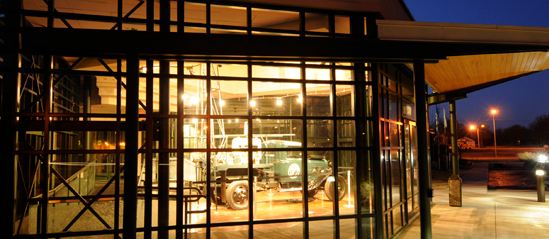
The Cherokee Strip Regional Heritage Center includes a 1927 portable drilling rig created by petroleum technology pioneer George E. Failing, who added a drilling rig to a Ford farm truck. The same engine that drove the sturdy truck across the oilfields was used to power its rotary drill.
Thanks to Ward’s commitment to building the facility, the Cherokee Strip Regional Heritage Center Inc. was created in 2005 through partnerships with the Oklahoma Historical Society (OHS), the Sons & Daughters of the Cherokee Strip Pioneers Association, and the Phillips University Legacy Foundation.
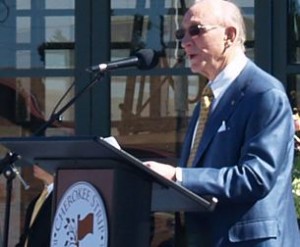
CSHHC Chairman Lew O. Ward (1939-2018) spoke at the 2011 opening. Ward served on the boards of the National Petroleum Council and the College of Engineering at the University of Oklahoma
The former heritage museum at the eastern edge of Enid became a property of the Oklahoma Historical Society in 1976 and is now the Cherokee Strip Regional Heritage Center, including the library.
Ward noted the new center’s oral history library contains more than 260 interviews capturing the stories of the Cherokee Strip from those who have lived them. “This growing library is an invaluable component of historical research for our region,” he added.
“Trained staff and volunteers collect the oral histories of people from the Cherokee Strip and Northwest Oklahoma,” Ward said. “The interviews are then transcribed and made available to the public and for use in the Research Center.”
Further, a the center has hosted teachers seminars on the Enid campus of Northwestern Oklahoma State University, according to Ward. The seminar explained to teaches how to incorporate lessons of leadership into their curriculum through the study of history,” he explained.
In November 2013, the center was selected by the Oklahoma Energy Resources Board (OERB) to partner in the statewide school education programs — OERB Homeroom.

In 1917, Herbert H. Champlin purchased a small refinery on the outskirts of Enid. By 1944 his company operated service stations in 20 states.
OERB spends millions of dollars annually to provide teacher training, curricula and programs that bring the petroleum industry to classrooms across the state — and offers free field trips to selected museums. “We are thrilled that the Heritage Center has been chosen to partner with OERB in their school education program,” said Museum Director Andi Holland in 2011.
“The heritage center’s Dave Donaldson Oil and Gas Gallery is well equipped marking the beginnings of oil and gas production in the Cherokee Strip through its economic importance to Northwestern Oklahoma today,” Holland added. The center’s gallery includes a series of interactive features about how natural resources are found, produced and refined.

A program already created by the heritage center’s education department is called “Boom and Bust, Natural Resources in the Cherokee Strip,” said Cody Jolliff, the Enid museum’s education director.
“This partnership will allow more students to attend the heritage center and learn more about Northwest Oklahoma and the rich natural resources that impact our lives,” Jolliff added.
Cherokee Strip Regional Heritage Center exhibits include: The Outlet – Learn about life before the land run, and how the run changed the course of history; The Land & the People Gallery – Hear the stories of settlers in the years after they staked their claims.
Also among the exhibits, the Thelma Gungoll Phillips University Gallery – Celebrate the founding and history of the first private university in the state.
The Dave Donaldson Oil & Gas Gallery offers a Champlin Oil exhibit. “The Champlin Refining Company, which for many years held the distinction of being the nation’s largest fully integrated oil company under private ownership, was based at Enid,” according to the Oklahoma Historical Society.
The Sooner State’s petroleum industry began one decade before statehood with an 1897 oilfield discovery near a trading post called Bartlesville.
_______________________
Recommended Reading: Oil in Oklahoma (1976); Oil And Gas In Oklahoma: Petroleum Geology In Oklahoma
(1976); Oil And Gas In Oklahoma: Petroleum Geology In Oklahoma (2013); The Oklahoma Petroleum Industry
(2013); The Oklahoma Petroleum Industry (1980). Your Amazon purchase benefits the American Oil & Gas Historical Society. As an Amazon Associate, AOGHS earns a commission from qualifying purchases.
(1980). Your Amazon purchase benefits the American Oil & Gas Historical Society. As an Amazon Associate, AOGHS earns a commission from qualifying purchases.
_______________________
The American Oil & Gas Historical Society preserves U.S. petroleum history. Please become an AOGHS annual supporter today and help maintain this energy education website and expand historical research. For more information, contact bawells@aoghs.org. Copyright © 2025 Bruce A. Wells. All rights reserved.
Citation Information – Article Title: “Cherokee Strip Regional Heritage Center.” Authors: B.A. Wells and K.L. Wells. Website Name: American Oil & Gas Historical Society. URL: https://aoghs.org/cherokee-strip-regional-heritage-center. Last Updated: March 28, 2025. Original Published Date: June 1, 2011.
by Bruce Wells | Feb 3, 2025 | Energy Education Resources
Growing oil demand challenged petroleum geologists, who organized a professional association.
As demand for petroleum grew during World War I, the science for finding oil and natural gas reserves remained obscure when a small group of geologists in 1917 organized what became the American Association of Petroleum Geologists (AAPG).
AAPG began as the Southwestern Association of Petroleum Geologists in Tulsa, Oklahoma, after about 90 geologists gathered at Henry Kendall College, now Tulsa University. They formed an association of earth scientists on February 10, 1917, “to which only reputable and recognized petroleum geologists are admitted.”
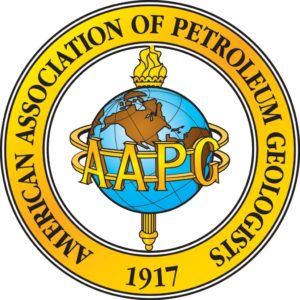
AAPG members maintain a professional business code.
Rapidly multiplying mechanized technologies of the “Great War” brought desperation to finding and producing vast supplies of oil. America entered the First War I two months after AAPG’s founding. An October 1917 giant oilfield discovery at Ranger, Texas, inspired a British War Cabinet member to declare, “The Allied cause floated to victory upon a wave of oil.”
Rock Hounds
In January 1918, the AAPG convention of in Oklahoma City reported 167 active members and 17 associate members. After adopting its present name one year after organizing at Henry Kendall College, the group issued its first technical bulletin, using papers and presentations delivered at the 1917 Tulsa meeting.
The professional “rock hounds” produced a mission statement that included promoting the science of geology, especially relating to oil and natural gas. The geologists also committed to encouraging “technology improvements in the methods of exploring for and exploiting these substances.”
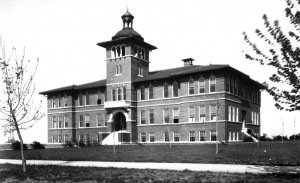
AAPG was founded in Tulsa, Oklahoma, at Henry Kendall College — today’s Tulsa University.
AAPG also began publishing a bimonthly journal that remains among the most respected in the industry. The peer-reviewed Bulletin included papers written by leading geologists of the day.
With a subscription price of five dollars, the journal was distributed to members, university libraries, and other industry professionals.
Finding Faults and Anticlines
By 1920, one petroleum trade magazine — after complaining of the industry’s lack of skilled geologists — noted the “Association Grows in Membership and Influence; Combats the Fakers.”
The article praised AAPG professionalism and warned of “the large number of unscrupulous and inadequately prepared men who are attempting to do geological work.”
Similarly, the Oil Trade Journal praised AAPG for its commitment “to censor the great mass of inadequately prepared and sometimes unscrupulous reports on geological problems, which are wholly misleading to the industry.”

Perhaps the best known such fabrication is related to the men behind the 1930 East Texas oilfield discovery — a report entitled “Geological, Topographical And Petroliferous Survey, Portion of Rusk County, Texas, Made for C.M. Joiner by A.D. Lloyd, Geologist And Petroleum Engineer.”
Using very scientific terminology, A.D. Lloyd’s document described Rusk County geology — its anticlines, faults, and a salt dome — all features associated with substantial oil deposits…and all completely fictitious.
The fabrications nevertheless attracted investors, allowing Joiner and “Doc” Lloyd to drill a well that uncovered a massive oil field, still the largest conventional oil reservoir in the lower-48 states.
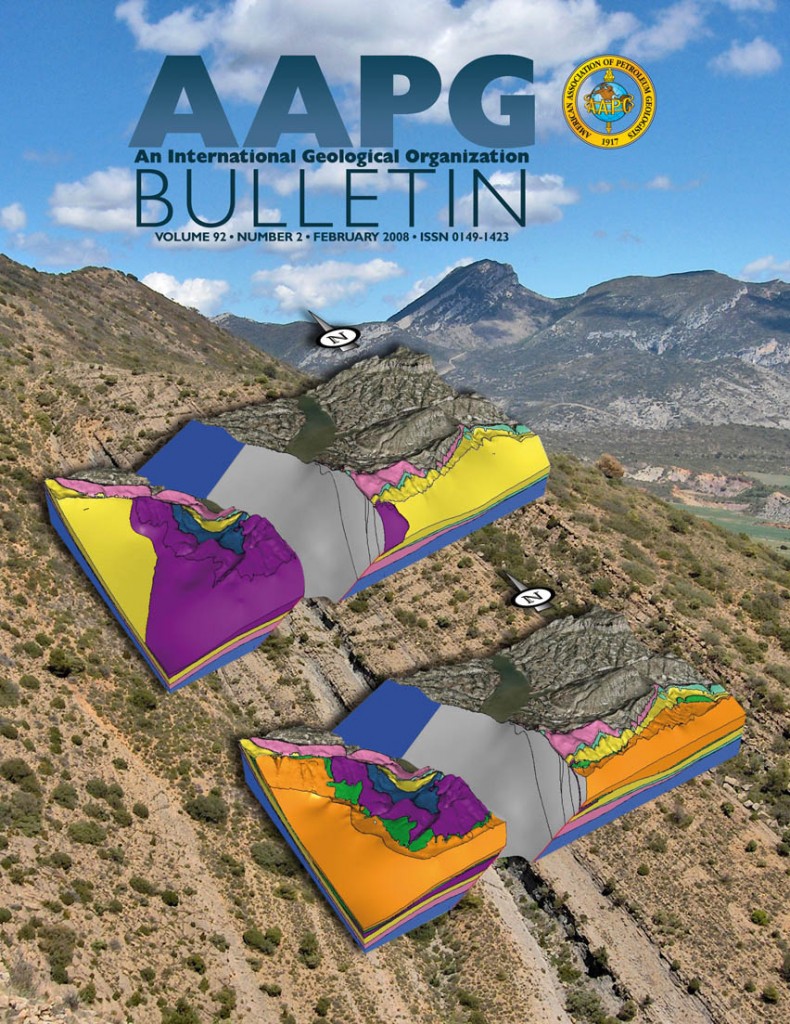
AAPG’s peer-reviewed journal first appeared in 1918, one year after the association’s first meeting in Tulsa.
Equally imaginative science came from Lloyd’s earlier descriptions of the “Yegua and Cook Mountain” formations and the thousands of seismographic registrations he ostensibly recorded. Lloyd, a former patent medicine salesman, and other self-proclaimed geologists, were the antithesis of the AAPG professional ethic.
In 1945, AAPG formed a “Committee on Boy Scout Literature” to assist the Boy Scouts of America in updating requirements for the “mining” badge, which had been awarded since 1911 (learn more in Merit Badge for Geology).

By 1953, AAPG membership had grown to more than 10,000 and a permanent headquarters building opened Tulsa. The association’s 2022 membership included about 40,000 members in 129 countries in the upstream energy industry, “who collaborate — and compete — to provide the means for humankind to thrive.”
The world’s largest professional geological society, a nonprofit organization, maintains a membership code to assure “integrity, business ethics, personal honor, and professional conduct.”
Oil Patch Historians
Longtime AAPG member Ray Sorenson, a Tulsa-based consulting geologist, has made numerous presentations about the history of petroleum. After publishing papers in leading academic journals, he adapted many of his contributions for the association’s 2007 Discovery Series, “First Impressions: Petroleum Geology at the Dawn of the North American Oil Industry.”
Further, Sorenson continued to research and collect a vast amount of material documenting the earliest signs of oil — worldwide references to hydrocarbons earlier that the 1859 first U.S. oil well drilled by Edwin Drake in Pennsylvania.

Drake expert and geologist and historian William Brice, professor emeritus at the University of Pittsburgh at Johnstown, in 2009 published Myth, Legend, Reality – Edwin Laurentine Drake and the Early Oil Industry. His 661-page epic was researched and written as part of the U.S. petroleum industry’s 150th anniversary (learn more in Edwin Drake and his Oil Well),
As part if AAPG’s 2017 centennial events, geologist Robbie Rice Gries published Anomalies: Pioneering Women in Petroleum Geology 1917-2017. Researched with help from AAPG volunteers, her 405-page book includes contributors’ personal stories, written correspondence, and photographs dating back to the early 1900s.
The stories in Gries’ book should be read by every petroleum geologist, geophysicist and petroleum engineer, according to independent producer Marlan Downey, founder of Roxanna Oil Company. “Partly for the pleasure of the sprightly told adventures, partly for a sense of history, and, significantly, because it engenders a proper respect towards all women professionals, forging their unique way in a ‘man’s world.’”
_______________________
Recommended Reading: Anomalies: Pioneering Women in Petroleum Geology 1917-2017 (2017); Trek of the Oil Finders: A History of Exploration for Petroleum (1975); Myth, Legend, Reality – Edwin Laurentine Drake and the Early Oil Industry (2009); The Prize: The Epic Quest for Oil, Money & Power (1991); The Birth of the Oil Industry (1936). Your Amazon purchase benefits the American Oil & Gas Historical Society. As an Amazon Associate, AOGHS earns a commission from qualifying purchases.
(2009); The Prize: The Epic Quest for Oil, Money & Power (1991); The Birth of the Oil Industry (1936). Your Amazon purchase benefits the American Oil & Gas Historical Society. As an Amazon Associate, AOGHS earns a commission from qualifying purchases.
_______________________
The American Oil & Gas Historical Society preserves U.S. petroleum history. Please become an AOGHS annual supporter and help maintain this energy education website and expand historical research. For more information, contact bawells@aoghs.org. Copyright © 2025 Bruce A. Wells. All rights reserved.
Citation Information – Article Title: “AAPG – Geology Pros since 1917.” Authors: B.A. Wells and K.L. Wells. Website Name: American Oil & Gas Historical Society. URL:https://aoghs.org/energy-education-resources/aapg-geology-pros-since-1917. Last Updated: February 4, 2025. Original Published Date: April 29, 2014.
by Bruce Wells | Sep 24, 2024 | Energy Education Resources
Western Pennsylvania collection of engines preserves a remarkable history of powering America.
Vintage oilfield engine exhibits are part of an unusual Pennsylvania museum in the rustic hills of Pennsylvania near Little Sandy Creek, just off Colonel Drake Highway 36, about 10 miles northwest of Punxsutawney.
Indoor and outdoor displays of rare engines, many carefully restored and maintained by volunteers, educate visitors about the 19th-century evolution of internal combustion technologies that helped end the age of steam.
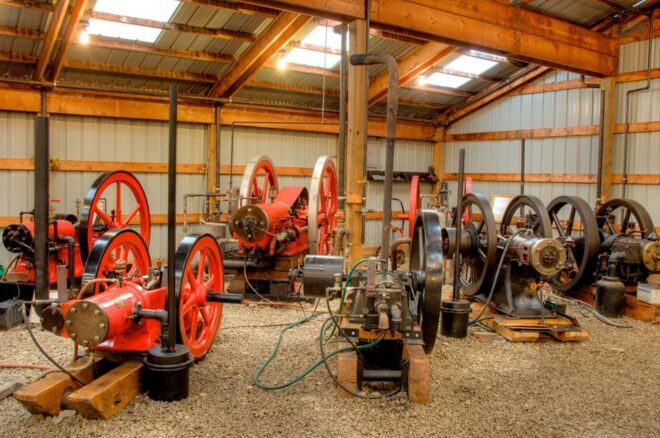
The Coolspring Power Museum opened in 1985 near Punxsutawney, Pennsylvania. It has the largest collection of historically significant stationary gas engines in the country, if not the world. Photo courtesy Coolspring Power Museum.
The Cool Spring Power Museum, which opened in 1985, exists thanks to its long-time director who spent decades collecting and preserving hundreds of engines of all shapes and sizes. In a 2004 interview, Dr. Paul E. Harvey explained why the collection was important.

“Internal combustion engines revolutionized the world around the turn of the 20th century in much the same way that steam engines did a century before,” noted Dr. Harvey, who co-founded the museum in 1985 about midway between Punxsutawney and Brookville, Pennsylvania.
“One has only to imagine a coal-fired, steam-powered, airplane to realize how important internal combustion was to the industrialized world,” added Dr. Harvey, a medical doctor.

The museum hosts many summer events, including a “History Day and Car, Truck & Tractor Show.” Photo by Bruce Wells.
According to Dr. Harvey, permanent exhibits at Coolspring include stationary gas “hit and miss” engines, throttle-governed engines, flame ignition engines, hot tube ignition engines, and hot air engines ranging in size from a fractional horsepower up to 600 horsepower.
Many engine enthusiasts from around the country have sent significant pieces for display, he said. The grounds, as well as semi-annual shows, have expanded with visitors from Maine to California, as well as Canada and England.
Dr. Harvey explained that early internal combustion engines produced only a few horsepower and could not replace steam engines in most applications, but by 1890 they were powerful enough for most portable or remote operations as well as many small manufacturers.

By 1900 the new power technology was replacing reciprocating steam engines for electric generation, Dr. Harvey noted. “By 1915 they were being considered for all but the largest installations where steam turbines have since dominated,” he added. Dr. Harvey and fellow enthusiast John Wilcox began collecting engines in the 1950s. Their collections were the basis of displays that would greatly multiply.
The museum is housed in 20 buildings that, besides its own large collection, contain many pieces placed there on loan. Dr. Harvey said the purpose of Coolspring was “to be the foremost collection of early internal combustion technology presented in an educational and visitor-oriented manner and to provide an operation that will gain support and generate substantial growth.”

Dr. Paul Harvey, co-founder of the Coolspring Power Museum in Pennsylvania, next to a 175 HP Otto engine he restored with help of museum volunteers. Photo courtesy the Coolspring Power Museum.
The collection documents the early history of the internal combustion revolution. Almost all of the critical components of today’s engines have their origins in the period represented by the collection (as well as hundreds of innovations no longer used). Some of the engines represent real engineering progress; others are more the product of inventive minds avoiding previous patents. All tell a story.
Although the museum’s focus is on stationary engines (with perhaps the largest collection anywhere), Dr. Harvey explained that no museum of internal combustion engines would be complete without at least a few vehicles in its collection. Among the antique heavy trucks and semis, is a rare petroleum well service rig.
The Hanley & Bird Well Bailing Machine was designed to clean a well by lifting water, sand, and debris from the bottom of the well using a “bailer” attached to a cable, noted the museum director.
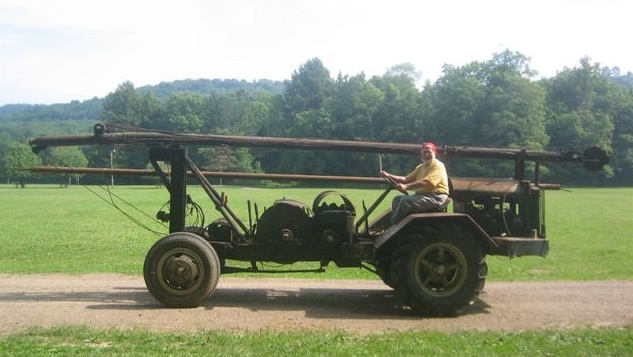
A “last of its kind” Hanley & Bird Well Bailing Machine from the Pennsylvania oilfields. Photo courtesy Coolspring Power Museum.
Five of the devices were built; the Coolspring Power Museum’s example is the only one to survive. “It was donated to the museum by EXCO Resources, the successor to H&B,” Dr. Harvey said. “It is very interesting as it uses a chain drive Mack rear end and a Ford front axle.”
Dr. Harvey recalled seeing the Hanley & Bird Well Bailing Machine driving through Coolspring on its way to service local natural gas wells. He said that the museum today displays it with the mast raised and ready to work. “It certainly shows the ingenuity of the local gas industry,” he reported.
The Coolspring Power Museum collection includes many engines used to power multiple wells in America’s first oilfields. The museum is off Route 36 midway between Punxsutawney and Brookville in western Pennsylvania.

As the steam engines revolutionized the world in the 1800s, the internal combustion engines on exhibit at the Coolspring Power Museum did the same at the start of the 20th century, according to Dr. Harvey.
“You have only to imagine a coal-fired, steam-powered, airplane to realize how important internal combustion was to the industrialized world,” the doctor added with a chuckle.
The Coolspring Power Museum hosts events in the spring and summer, including the History Day and Car, Truck & Tractor Show. The 2024 Spring Exposition included the museum bringing back its popular late 19th-century Foos Gas Engine Company gasoline engine (with timed fuel injection rather than a carburetor) and noting, “Foos was a very successful engine builder of a variety of types and sizes of efficient engines.”
_______________________
Recommended Reading: Around Titusville, Pa., Images of America (2004); Myth, Legend, Reality: Edwin Laurentine Drake and the Early Oil Industry
(2004); Myth, Legend, Reality: Edwin Laurentine Drake and the Early Oil Industry (2009); Oil on the Brain: Petroleum’s Long, Strange Trip to Your Tank
(2009); Oil on the Brain: Petroleum’s Long, Strange Trip to Your Tank (2008); A History of the New York International Auto Show: 1900-2000
(2008); A History of the New York International Auto Show: 1900-2000 (2000). Your Amazon purchase benefits the American Oil & Gas Historical Society. As an Amazon Associate, AOGHS earns a commission from qualifying purchases.
(2000). Your Amazon purchase benefits the American Oil & Gas Historical Society. As an Amazon Associate, AOGHS earns a commission from qualifying purchases.
_______________________
The American Oil & Gas Historical Society (AOGHS) preserves U.S. petroleum history. Please become an AOGHS annual supporter and help maintain this website and expand historical research. For more information, contact bawells@aoghs.org. Copyright © 2024 Bruce A. Wells. All rights reserved.
Citation Information: Article Title: “Cool Coolspring Power Museum.” Authors: B.A. Wells and K.L. Wells. Website Name: American Oil & Gas Historical Society. URL: https://aoghs.org/energy-education-resources/cool-coolspring-power-museum. Last Updated: September 30, 2024. Original Published Date: September 1, 2005.
.
by Bruce Wells | Jun 27, 2024 | Energy Education Resources
Discoveries in the 1920s led to a giant oilfield in 1957.
A 1961 Clare County historical marker explains Michigan petroleum history began in 1886, but that Michigan State Geologist Alexander Winchell had reported that oil and natural gas deposits lay under Michigan’s surface as early as 1860.
“First commercial oil production was at Port Huron, where 22 wells were drilled, beginning in 1886,” the marker notes. “Total output was small. Michigan’s first oil boom was at Saginaw, where production began about 1925. About three hundred wells were drilled here by 1927, when Muskegon’s ‘Discovery Well’ drew oil men from all over the country to that field.”
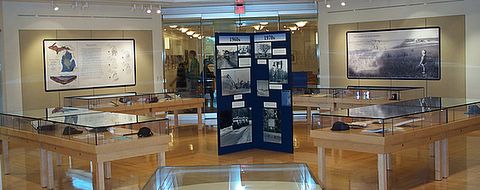
“Michigan Oil & Gas History,” a 2005 Clarke Historical Library exhibit at Central Michigan University, Mount Pleasant. Photo by Kristin L. Wells.
The Clare County historical marker notes that the Mt. Pleasant field, discovered in 1928, “helped make Michigan one of the leading oil producers of the eastern United States. Mount Pleasant became known as the “Oil Capital of Michigan.”
Central Michigan University Oil Exhibit
In the summer of 2005, a special petroleum exhibit opened at Central Michigan University’s (CMU) Clarke Historical Library, Mount Pleasant.

“They work hard, take risks, prosper, and by and large benefit everybody,” noted Frank Boles, director of the Clarke Historical Library, about oil and natural gas producers. “What I didn’t understand about the industry is that these people all know each other.”
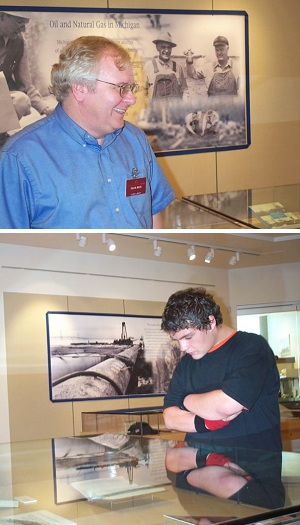
Frank Boles (top), director of the Clarke Historical Library, designed an exhibit creatively combining documents and photographs to capture the attention of students. Photos by Kristin L. Wells.
The library told their story with an “Oil and Natural Gas in Michigan” exhibit.
The state’s abundant oil production comes as a surprise to many, said Boles, who put the exhibit together with the cooperation of the Michigan Oil & Gas Association and the Michigan Oil & Gas Producers Educational Foundation.
Jack Westbrook, retired managing editor of Michigan Oil & Gas News magazine, marshaled the resources and worked tirelessly to ensure success, Boles said. “In a very real sense, there would be no exhibit if it were not for Jack.”

The exhibit was designed to designed to pique a visitor’s curiosity – and be transportable. The region’s students learned that Mount Pleasant, home to CMU, had its own oil boom in 1928 and today is known as the historical center of Michigan’s oil industry.
Exhibit visitors learned that more than 57,000 oil and gas wells had been drilled in their state since 1925 — and that Michigan ranks 17th in nationwide oil production and 11th in natural gas. More surprises awaited those students who looked more closely, Boles said.
“We’re about usage,” he explained. “Our profit is people coming in, using our resources, and hopefully learning something. We want our exhibits to prompt them to dig deeper.”
Golden Gulch of Oil
Clarke Historical Library visitors learned about late 1920s oil discoveries and that after decades of dry holes or small oil finds, a January 7, 1957, Houseknecht No. 1 well revealed Michigan’s largest oilfield, 29-miles-long. Ferne Houseknecht had convinced her uncle, Clifford Perry, to take time between his other farm projects to drill the historic well.
Learn more in Michigan’s Golden Gulch of Oil.
For the Clarke Historical Library exhibit, Boles used six walls and eleven cabinets to tell this and other stories, so careful planning was essential. He said that from the project’s outset, pursuit of community support, resources, and partners was essential.
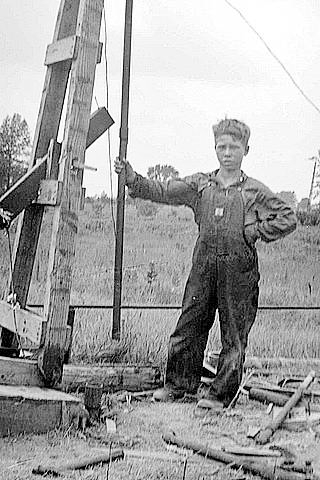
Showing off his homemade cable tool rig in 1932, Earl “Red” Perry Jr., 12, was the nephew of Cliff Perry — who would discover Michigan’s largest oilfield in 1957. Photo courtesy Clarke Historical Library, Central Michigan University.
The exhibit began with storyboarding and the interactive process of writing and rewriting proposed text. Large photo formats with understandable text dominated the walls, while display cases featured unique artifacts and documents.
Visitors discovered a rich oil history and learned of the complex environmental issues Michigan has successfully addressed.
The 1970s “Pigeon River State Forest” ecological controversy was presented — along with its innovative solution. In 1976, Michigan became the first state in the nation to earmark state revenue generated through mineral, including oil and gas, activity for acquisition and improvement of environmentally sensitive or public recreation lands.

According to Jack Westbrook, all 83 Michigan counties have benefited from the fund’s $635 million collected from oil and gas revenues — and other states followed Michigan’s example. His book, Michigan Natural Resources Trust Fund 1976-2011: A 35 year Michigan investment heritage in Michigan’s public recreation future, can be found on Amazon Books (link below).
Visit the Clarke Historical Library.
_______________________
Recommended Reading: American Oil And Gas History Book: Michigan’s Golden Gulch Of Oil: The Great Depression (2021); At Home in Earlier Mt. Pleasant Michigan: A visit with our neighbors of the past (2021); Michigan Natural Resources Trust Fund 1976-2011: A 35-year Michigan Oil and Gas Industry Investment Heritage in Michigan’s Public Recreation Future (2011); Handbook of Petroleum Refining Processes
(2011); Handbook of Petroleum Refining Processes (2016).
(2016).
_______________________
The American Oil & Gas Historical Society preserves U.S. petroleum history. Become an annual AOGHS annual supporter and help maintain this energy education website and expand historical research. For more information, contact bawells@aoghs.org. Copyright © 2024 Bruce A. Wells. All rights reserved.
Citation Information – Article Title: “Michigan Petroleum History.” Authors: B.A. Wells and K.L. Wells. Website Name: American Oil & Gas Historical Society. URL: https://aoghs.org/energy-education-resources/exhibiting-michigan-petroleum-history. Last Updated: November 12, 2024. Original Published Date: June 19, 2014.
by Bruce Wells | Jun 23, 2024 | Energy Education Resources
Volunteers are key to Oblong museum’s Illinois Basin exhibits and events.
Building a community oil museum is not for the faint of heart. “Money and volunteers, volunteers and money,” are the biggest challenges, according to John Larrabee, board president for the Illinois Oil Field Museum and Resource Center on the outskirts of his hometown of Oblong, Illinois.

The Illinois Oil Field Museum is located in Oblong, Illinois, on Highway 33, southeast of Effingham. First opened in 1961, the museum moved into a new building in 2001. Photos by Kristin L. Wells.
“The first thing you have to have is a goal and the determination to keep at it, no matter what. Don’t give up, whatever happens,” Larrabee explained in a 2004 interview with Kris Wells, American Oil & Gas Historical Society volunteer researcher and contributing editor. (more…)
by Bruce Wells | Apr 29, 2024 | Energy Education Resources
Petroleum geologists helped create the Boy Scouts of America geology merit badge in 1953.
The Boy Scouts of America’s geology merit badge began in 1911 as a mining badge — one of less than 30 scouting badges. The mining merit badge in 1937 changed to rocks and minerals before becoming the geology badge in 1953.
The story behind the geology merit badge is best told by a member of the Houston Geological Society (HGS), a resource for potential badge earners.

Petroleum geologists helped inspire the Geology merit badge adopted in 1953.
Petroleum geologist Jeff Spencer, himself an Eagle Scout, has published dozens of petroleum history papers and frequently contributed to Oil-Industry History, the peer-reviewed journal of the Petroleum History Institute (PHI), Oil City, Pennsylvania.
According to Spencer, the original Boy Scouts mining merit badge had several basic requirements, including naming at least 50 minerals; describing the 14 great divisions of the earth’s crust; and defining terms like watershed, delta, drift, fault, glacier, terrace and stratum.

Scouts seeking the mining badge also were asked to identify 10 different kinds of rock and describe methods for mine ventilation and safety devices,
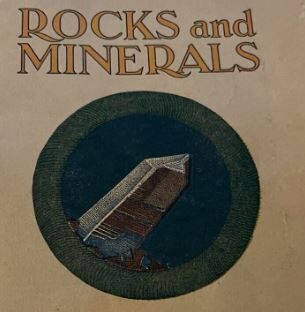
Scouts earned the Rocks & Minerals badge from 1937 until 1953.
The first mention of oil and natural gas appeared in 1927 — the mining badge requirement asked Scouts to “explain how we locate petroleum and natural gas pools, and how we obtain oil and gas,” Spencer notes.
In September 1937, the mining merit badge (a shovel) was replaced with the rocks and minerals badge (a crystal). The first merit badge booklet was published the same year by Daniel O ’Connell, chairman of the department of geology at the City College of New York.
O’Connell’s “Rocks and Minerals” booklet would go through through many revised printings in the next ten years, according to the Geological Society of America (GSA).
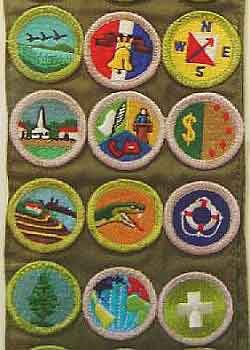
The first 12 merit badges of the Boy Scouts of America, which encourages visits to science museums and geology departments of local universities.
In 2014, thanks in part to the Society for Mining and Metallurgy (SME), the mining merit badge returned as “Mining and Society.”
Petroleum Geologists
In 1945, the American Association of Petroleum Geologists (AAPG) formed a “Committee on Boy Scout Literature” at the urging of industry leaders, including A.C. Bace, a geologist with Stanolind, and George W. Pirtlem, an independent geologist from Tyler, Texas.
Oklahoma geologist Frank Gouin chaired the AAPG committee’s effort to revise the merit badge and its requirements, and the geology badge officially replaced the Rocks and Minerals badge in 1953.

Spencer notes that the 1953 merit badge’s description of what a geologist does said that four out of five geologists become “oil geologists” with an expected starting salary of $300 per month.
“You may have to be a nomad instead of settling down for life in one spot,” the description continued. “You may have to ‘sit on’ a well all night and then drive a hundred miles to report on it. You may have to burn in India, freeze in Alaska, or do both in the Texas Panhandle.”
Although minor revisions of the geology merit badge occurred in 1957, the next major change came in 1982, adding anticlines, synclines, and faults with a requirement to draw simple diagrams showing unconformity, strikes and dips.
The last major revision of the geology badge occurred in 1985, Spencer says, again with the cooperation of AAPG leadership. The badge now has 13 requirements, organized under five categories: earth materials, earth processes, earth history, geology and people, and careers in geology.
- The earth materials section includes the collection and identification of rocks and minerals.
- The earth processes section covers geomorphology, the hydrologic cycle, volcanoes, mountain building, and the ocean floor.
- The earth history section includes the geologic time chart, fossils, and continental drift. The geology and people section covers environmental geology and energy sources with a field trip option in this category.
In addition to its involvement in merit badges, AAPG and its chapters serve the scouting program in many ways, Spencer concludes. The Houston Geological Society has sponsored “Explorer Posts” and worked with the Houston Museum of Natural Science to teach the elements of earning the badge.

OPEC-inspired energy badge.
There now are more than 120 merit badges. The OPEC oil embargo of 1973 — and the need for energy conservation — led to creation of an energy merit badge in 1977.

In 2013, Jeff Spencer published a selection of oil patch post cards via Arcadia Publishing’s postcard history series. Texas Oil and Gas includes more than 200 vintage black-and-white images through decades of oil booms throughout the state.
Chapters reflect the Lone Star State’s petroleum heritage by region, including “Spindletop and the Golden Triangle,” a prolific area in southeast Texas between Beaumont, Port Arthur and Orange (read more about Spencer’s Texas oil postcards).
_______________________
Recommended Reading: Texas Oil and Gas, Postcard History (2013); Trek of the Oil Finders: A History of Exploration for Petroleum (1975); Anomalies: Pioneering Women in Petroleum Geology 1917-2017 (2017). Your Amazon purchase benefits the American Oil & Gas Historical Society. As an Amazon Associate, AOGHS earns a commission from qualifying purchases.
(2013); Trek of the Oil Finders: A History of Exploration for Petroleum (1975); Anomalies: Pioneering Women in Petroleum Geology 1917-2017 (2017). Your Amazon purchase benefits the American Oil & Gas Historical Society. As an Amazon Associate, AOGHS earns a commission from qualifying purchases.
_______________________
The American Oil & Gas Historical Society (AOGHS) preserves U.S. petroleum history. Please become an AOGHS annual supporter and help maintain this energy education website and expand historical research. For more information, contact bawells@aoghs.org. Copyright © 2024 Bruce A. Wells. All rights reserved.
Citation Information: Article Title – “Merit Badge for Geology.” Authors: Aoghs.org Editors. Website Name: American Oil & Gas Historical Society. URL: https://aoghs.org/energy-education-resources/geology-merit-badge. Last Updated: May 1, 2024. Original Published Date: June 1, 2008.




(1976); Oil And Gas In Oklahoma: Petroleum Geology In Oklahoma
(2013); The Oklahoma Petroleum Industry
(1980). Your Amazon purchase benefits the American Oil & Gas Historical Society. As an Amazon Associate, AOGHS earns a commission from qualifying purchases.


















